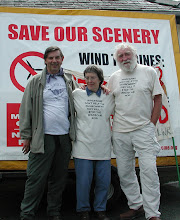A TERRIBLE COST TO THE LANDSCAPE
Closing speeches were made in Tiverton on Tuesday in the Public Inquiry into the Three Moors and Bickham wind farms proposed close to each other on the edge of Exmoor. Airtricity’s application to erect nine 105m turbines around Knowstone had been turned down by the North Devon District Council and Coronation Power was appealing against Mid Devon’s rejection of a proposal for four nearby, but sited in Mid Devon. With another application for nine turbines at Batsworthy Cross, opposite the Three Moors site, waiting in the wings, the Inspector was invited to consider the cumulative effect.
David Cocks QC appeared for the Rural Exmoor Alliance, an opposition group formed by the Exmoor Society, the CPRE and the Two Moors group of local protestors. Summarising the evidence heard over six weeks he said that the admittedly minute contribution that these two wind farms would make to the global warming issue was not a reason in itself for refusing planning permission. However the extraordinary inaccuracy of the developers’ claims certainly did need to be taken into account. The emissions savings from each had been shown to have been exaggerated by nearly three times. The amount of electricity to be produced had also been exaggerated; it would not apparently be more than 25% of the turbines’ capacity, or even less according to the type of turbine used.
Such uncertainties were characteristic of most of the developers’ evidence.
All the landscape experts had agreed that the Exmoor Fringe and moorland countryside of the sites were of high quality and value, open, remote and tranquil. All had agreed that the effects of the turbines on the views, from and towards the Exmoor National Park, would be significant and in many cases major. Yet the developers’ experts had then tried to argue, for instance, that only within 3 km of a turbine would this matter, or that the landscape “could absorb” them. The Bickham report had ignored the issue of tranquillity altogether.
The Inquiry spent much time on the extent to which the noise from turbines can be predicted. The science is inexact and government guidelines on limits were drawn up when turbines were half the height of those proposed. Wind speeds are different at 100 m from those at ground level and the distance between the turbines themselves can also affect the noise produced. Background noise has to be measured to calculate the impact of the noise being added. Cross examination of the developers’ experts showed defective data in all these areas; the implication, said Mr Cocks, was a massive non-compliance with government limits.
On tourism, the developers had argued there would be no adverse effects. This was based on a survey of businesses, conducted by telephone. No visuals of the sites had been shown to the interviewees and no record kept of what was said. More astonishing was the absence of any information on the size of the 55 businesses interviewed; did this represent 55 jobs or 550? Not a single tourist had been asked their opinion. On ecology, one bat survey had been based on the wrong turbine lay out and none had covered the whole year.
Finally, Mr Cocks suggested, a new pattern is emerging in policy on renewable energy and carbon emissions. On shore wind farms like these are looking less fashionable, and the huge subsidies they require from consumers will inevitably be redirected towards more effective technologies. The evidence called by the developers throughout the Inquiry had shown how difficult it is to support a misguided and fading technology. The small benefit that would be gained would be a terrible cost to the landscape, and both appeals should be refused.

No comments:
Post a Comment